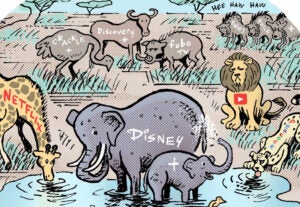 “Data Driven Thinking” is written by members of the media community and contains fresh ideas on the digital revolution in media.
“Data Driven Thinking” is written by members of the media community and contains fresh ideas on the digital revolution in media.
Today’s column is written by Eric Picard, CEO at Rare Crowds.
One of the most common conversations I have on a regular basis about startups, especially in the ad technology space is whether a company has legs. Will they be able to grow large and “go it alone,” or are they really just a feature of a bigger system or platform that hasn’t been added yet? This line of thinking is super important for investors to understand, and a key part of the decision-making process for entrepreneurs as they begin building a company.
Why does this matter?
Investors all have their own set of criteria for how they evaluate investments. Angels and Micro-VCs frequently are willing to invest in companies that are built for a relatively short term flip. They ask, “Can the company build a robust set of features that attract a set of customers in the short term, run at a low burn rate (or even quickly become profitable), integrate with one or more existing platforms, and then get bought within one to three years for a decent return?” In this case, building a company that’s a feature is completely viable and acceptable.
This approach is great if the startup can either bootstrap (not take any money) or just pull in a small amount of investment capital and get profitable (or exit) quickly. For angels and micro-VCs, this kind of investment is great because they can get fantastic returns on a short investment horizon, and sometimes it gets them stock in a larger high flying tech company at a great multiple. Sometimes these will be companies at Series B or C rounds that they couldn’t get into, sometimes they’re large publicly traded companies that the investor gets stock in at a significant market discount.
If the startup is going to need significant capital, it must be able to build a large business that has significant revenues and long sustainable growth. It needs to be able to stand alone for three to six years, and during that time build a large company with an opportunity to exit for greater than $100M – and have a credible story for why they could be worth more than $1B and exit via either an IPO or a significant acquisition.
There have been several examples in the past few years of companies that have been funded as if they were a full standalone company that could build massive revenue and exit big. They’ve taken tens of millions of dollars in funding, and need to either IPO or exit for greater than $100M to be seen as a win by their investors. In these cases, the investors couldn’t properly evaluate if the startup was really a feature or a standalone. So it’s important to have a way to evaluate this in order to avoid making those mistakes – both as an investor and an entrepreneur.
Question 1: Will Google or another big company just add this functionality to its existing product?
Many big companies with significant platform investments will constantly extend their product set over time. Big companies (Google, Microsoft, Yahoo, Amazon, AOL) and the big ad-tech specific companies (AppNexus, Rubicon, Pubmatic, MediaMath, etc.) have large engineering teams, and the reality is that it’s most efficient for large engineering teams to work on large, complex and technically prohibitively problems. They tend to add smaller features on a much slower cycle. That doesn’t mean they won’t add them – it just means they have bigger problems to solve that are higher priority – especially around scale, stability, and redundancy. But eventually they’re going to need to add those features, and they’ll do it either through acquisition or committing resources to build the features. At that point, they’ll be doing what’s known as a “build/buy analysis” to determine where to invest the capital to get the product to their customers. The analysis is going to look something like this:
- How many man-hours of development will this take to build?
- What’s the cost to develop it in-house, both the actual cost of development and the opportunity cost in both time to market, and the other features that the team won’t be able to work on during the development process?
- The answer is likely to come out between $6 and $30 million – with a rare outside answer landing around $50 to $80 million, depending on the complexity of the feature.
- That means that for most “feature” companies, exits will be in those ranges, with perhaps a 10 to 20% premium applied. The likelihood of a premium relates directly to how much revenue the company brings with it, minus any costs of both operating the company and integration costs.
This means that startups need to think through a bunch of things if they’re building for acquisition. They should be cheap to buy – ideally in the first range we just discussed. They should be easy to integrate. They should have as few redundant systems and features as possible. They should be architected for scale – to handle the kinds of load that one of those big companies will need to transfer onto their systems post acquisition. But they should be cost effective operationally.
One very smart thing “feature” startups should do as early in their life cycle as possible is integrate with as many of those companies as possible. Thus when that build/buy analysis is done by the acquiring company, the startup is already integrated, is top of mind with the acquirer, and already is familiar with how to develop against their APIs. And in many cases the developers within the startup will already be known by at least some of the developers within the larger company.
Another big question that will come up during due diligence by an acquiring company is whether the startup has any redundant systems that will need to be decommissioned or moved into internal data centers. This is more important than many would realize – especially when it comes to datacenter redundancy. Very few startups have the kind of security and cost efficiencies that a Google, Microsoft or Amazon have in house. So if they’ve invested in their own infrastructure, they’re going to need to move this out of their datacenter and into the bigger company’s infrastructure. Datacenter contracts should be crafted to facilitate this – and hardware is probably just a loss. Building in the cloud can solve this in some cases, but in others, might cause problems of their own – e.g. any real time systems built in the cloud are highly unlikely to scale to cover the needs of a big company. Architecting for scale, even if the startup doesn’t scale up right away, is a critical consideration.
Question 2: How do we define a “standalone” business, and what justifies the higher acquisition costs?
First and foremost consideration in this case is revenue. Companies with deep customer relationships and lots of revenue can both run standalone, and/or be acquired for a large amount of money at significant multiples. Think of a few companies that have been acquired on that scale: AdMeld built a real and significant business that had deep customer relationships, real revenue, and was acquired by Google for a significant premium at a high price. Same goes for Invite Media and DoubleClick, both bought by Google; aQuantive, bought by Microsoft; and Right Media, bought by Yahoo.
All of these companies built significant businesses, with large numbers of customers, decent margins, and were not bought for their technology. In each of those cases, the core technology of each company was completely re-architected and redeveloped by the acquirer (in aQuantive’s case, a little less so).
So when starting a company, and when evaluating that company for investment, one must consider how much revenue, and how many customer relationships, the company can effectively build over a three to six year period. If the answer to both questions is “lots,” and a credible case can be made – then consideration for this kind of investment (both in time/effort from the entrepreneur and cash from the investors) is justified.
Other considerations for whether the business will stand the test of time:
How “sticky” will those relationships be? Ad serving is the penultimate example of a sticky ad technology. It’s so complex and cost prohibitive to switch out your ad server – either for publishers or agencies – that it almost never happens. That’s one reason ad servers with lots of traction were bought for such huge premiums, even though there was significant price compression over time. If the technology is sticky because of integrations into either infrastructure or business processes, it’s a good candidate to be a standalone.
Does the company sell a product, service or commodity that has transfer-pricing pressure? Or, does the company either create the product it sells from scratch or process the product of another company in a way that adds significant value? Ideally in the latter scenario it would do this in a way that is difficult to replicate – for example, by analyzing big data with some unique and differentiated methods in order to add intelligence and value to what it sells.
Transfer pricing pressure is critical to understand: The best current example of transfer pricing pressure is music. Any business that has started in the music space has been doomed to either incredibly poor margins or instability. This is because the music companies can simply increase the costs of the final good being sold (songs or albums) any time they please. As soon as one of the companies selling music digitally begins to get profitable, the music industry can throttle their margins by increasing price. In the advertising space this is similar to a problem early ad networks had – the ad rep firms. Because the ad rep firms didn’t own the inventory they sold, and re-sold the product of the publisher directly with no additional value, they were doomed to low multiple exits and low valuations if they managed to get large enough to IPO.
A recent example of transformation in a category that shows how some of these standalone companies have become more resilient is the data companies. They started out with relatively undifferentiated mechanisms to create targeting segments that led to the creation of ad networks, then were integrated with data marketplaces on the exchanges, and now have transformed themselves into Data Management Platforms. Lotame is a great example of a company that has made this transition – but many others have as well.
By applying this type of analysis to opportunities to create a company or invest in a company, entrepreneurs and investors can make smart decisions about what to build, and what to invest in.
Follow Eric Picard (@ericpicard) and AdExchanger (@adexchanger) on Twitter.












